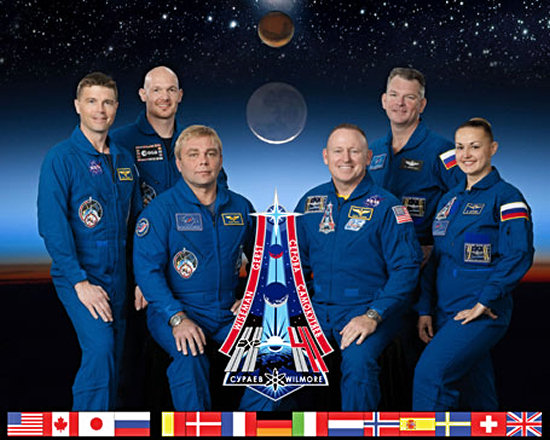 I like to keep tabs on who’s coming and going on the currently only human outpost in space, the International Space Station. Like every Spring and Autumn, it’s again time for crew changeovers with several of the half-year missions overlapping and ensuring that there are at least three, normally six but sometimes even nine astronauts on the station. Right now, there are only three up there, but tomorrow’s Soyuz launch will bring the crew contigent back up to six – and this expedition and the one that will be following it in November will be very special ones indeed. Let’s see who is coming, who is going and what other space traffic is in the vicinity of the ISS. [Image: Crew photo of Expedition 41]
I like to keep tabs on who’s coming and going on the currently only human outpost in space, the International Space Station. Like every Spring and Autumn, it’s again time for crew changeovers with several of the half-year missions overlapping and ensuring that there are at least three, normally six but sometimes even nine astronauts on the station. Right now, there are only three up there, but tomorrow’s Soyuz launch will bring the crew contigent back up to six – and this expedition and the one that will be following it in November will be very special ones indeed. Let’s see who is coming, who is going and what other space traffic is in the vicinity of the ISS. [Image: Crew photo of Expedition 41]
Who went home: Steven R. Swanson, Aleksandr Skvortsov and Oleg Artemyev already went home on September 10th, formally ending Expedition 40 and leaving the station temporarily with “only” three people on board.
Who is up: Maksim Surayev, Reid Wiseman & Alexander Gerst, the Russian-American-German trio, have launched to the station in May and will remain on board until November as the first half of Expedition 41. All three have been tirelessy working on numerous scientific experiments and all the while are still posting a lot of photos from orbit on the social networks (@msuraev, @astro_reid and @astro_alex on Twitter), attracting the media’s attention somewhat more than usual. Especially Alexander Gerst has been interviewed on the station numerous times by German television, providing a lot more exposure than usual.
Who is coming: Aleksandr Samokutyayev, Yelena Serova and Barry E. Wilmore are launching tomorrowo September 25th on 4:23pm EDT (8:23pm UTC) as the second half of Expedition 41. Yelena Serowa will be the first female Russian Cosmonaut on the station, while Barry “Butch” Wilmore is on his second visit after a short 11-day mission in 2011 and Samokutyayev also has one long-duration mission with 164 days in 2011 under his belt. [Update: the launch was a success and the three new crewmembers have safely arrived on board the station, taking the quick way up in only a few hours. The NASA TV Youtube Channel has the videos from the launch and from the arrival, docking and welcome!]
The three Cosmonauts and Astronauts will stay on the station until March 2015, during which the press will undoubtedly make a lot of fuss about the fact that Yelena Serowa is the first female space traveler from Russia visiting the ISS. Although women Cosmonauts are generally rare and she is the first Russian woman going to the ISS, she is not the first female Russian visitor of a space station – that honour belongs to Svetlana Savitskaya, who went twice to Salyut 7 in 1982 and 1984 and was also the first Russian Cosmonaut to walk in space. Yelena Kondakova also visited Mir twice in 1994 and 1997, the second time even on a Space Shuttle flight, so Yelena Serowa is continuing the rare exception of female Cosmonauts that began with Valentina Tereshkova in the 1960s.
Who is preparing: Anton Shkaplerov, Samantha Cristoforetti and Terry W. Virts are launching on November 23, 3:59pm EDT and have been very busy in the last few months getting ready for their flight. @AstroSamantha and @AstroTerry are nevertheless still regularly using Twitter and Cristoforetti is still writing her detailed Logbook on Google+. She also unveiled an utterly awesome poster for their Expedition 42 yesterday on Google+ honouring none other than Douglas Adams. Shkaplerov, Cristoforetti and Virts will be on the station until May 2015.
There has also been a lot of space freighter traffic this summer on the ISS – the fourth cargo flight of the SpaceX Dragon has just arrived this week (with, amongst other things, a 3D printer on board!) and the last of the only five European ATV freighters also docked without problems previously in August as did the Orbital Sciences Cygnus capsule in July.
The biggest news regarding the ISS was, however, that NASA has awarded the coveted Space Taxi contracts to both SpaceX and Boeing for the human-rated Dragon and the CST-100, meaning that starting in 2017 the Russian Soyuz flights won’t be the only way to reach the space station anymore – test flights may happen as early as late next year.While the political propaganda and rhetoric have quieted down somewhat now and the Ukrainian crisis has had no direct consequences yet to the future of the ISS, the decision to award the human spaceflight contracts to two companies and not only one must undoubtedly have been influenced by this.